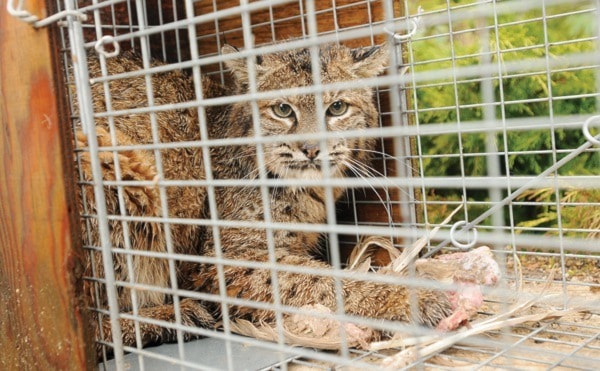Dave Rempel thought it was a goner, but much to his chagrin, the cat came back
Just like the eponymous star of the nursery rhyme made famous by Fred Penner, the wild bobcat that had been terrorizing Rempel’s east Maple Ridge bird sanctuary recently returned after being relocated by conservation officers in late April.
Rempel raises ducks, geese, pheasants, peacocks, swans, emus, pigeons, and chickens on his Maple Ridge hobby farm. So far he estimates the bobcat has killed more than $3,000 worth of birds, including some Australian black swans.
“This has never happened in 25-plus years,” he said. “Even the [conservation officer] said he had only seen two bobcats in his lifetime.”
Rempel, who is also a trustee on the Maple Ridge-Pitt Meadows Board of Education, trapped the bobcat back in April after it began to feast on his birds.
However, after a rash of bird kills in the past week, he’s concerned the bobcat has made its way back to the property.
“I think it may have been released too close by,” Rempel said.
He has put the trap out again in three or four different locations, but the bobcat isn’t falling for it.
“I wonder if it’s too smart for traps now,” he said.
Rempel’s property contains 24 small ponds with fencing around them, housing more than 150 migratory and non-migratory birds.
He has had to move many of his birds into one of the five secure aviaries for protection. Rempel said he also plans to electrify his exterior fencing.
“It’s a lot of work to fortify the property,” Rempel said. “I have no idea what else to do.”
Conservation officer Cody Ambrose released the bobcat in the Stave Lake area, about 30 km from where it was caught.
However, Ambrose says it’s unlikely the bobcat currently wreaking havoc on Rempel’s property is the same one trapped in April.
“[The Stave Lake area] has an adequate food source of small mammals and birds,” he said.
Bobcats live in warmer regions with a range that stretches over much of the U.S., parts of Canada and south into central Mexico. Their diet includes mice, fish, snakes, birds, carrion and small ungulates such as deer. Like its cousin, the lynx, the bobcat is also a major predator of rabbit and hare.
“Bobcats aren’t a public safety problem and don’t pose a significant danger to the public,” said Ambrose. “But like any wild animal, give them space and leave them be.”
If confronted by a bobcat, Ambrose said to keep as much distance between you and the bobcat, back away slowly and don’t run. When safe to do so, make as much noise as possible to scare the it away.
People with livestock can avoid problems by properly installing electric fences and managing attractants.
Report
British Columbia offers 24-hour access to report wildlife conflict concerns or violations of provincial regulations or legislation: 1-877-952-7277.
